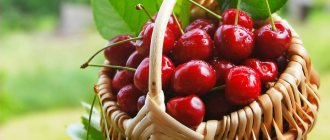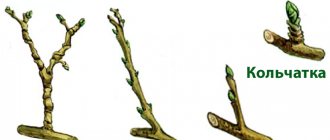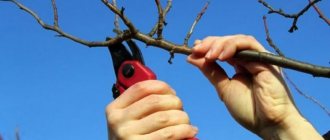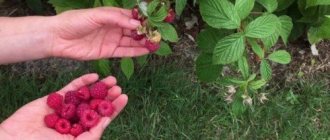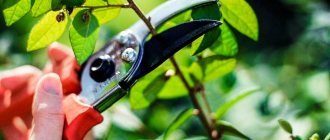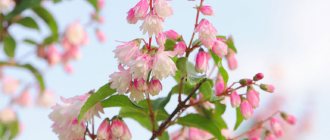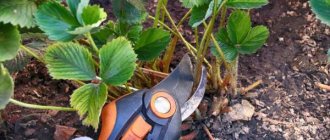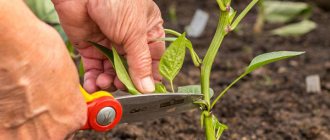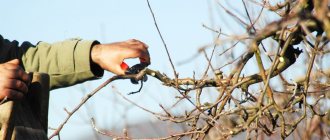The first pruning of the cherry tree should be done immediately after planting the seedling. In the future, this procedure should become a habit for every gardener who dreams of a bountiful harvest.
Cherry is one of those crops whose crown thickens quickly. And the denser it is, the worse the harvest will be and the smaller the fruits. So why not help the plant? Moreover, mastering the science of proper pruning of cherries is not so difficult.
Cherry trees can be pruned in spring or autumn, but more often this is done in the spring, before the buds have yet begun to bloom.
Pruning young cherries - first year
The cherry tree pruning scheme is quite simple if you are not going to give the crown any special shape. It all starts with shortening the crown of the annual tree by 18-22 cm. This is done not in early spring, but in mid-June, when young growths slowly begin to appear from the buds that you left.
First, you need to visually identify the so-called standard zone on the seedling. Usually this is a part of the seedling from the root collar (in other words, from the soil level) to a height of 45-50 cm. The trunk must be bare: all shoots on it that grow from the buds must be removed immediately. And from those shoots that grow above the trunk zone, you should choose five of the strongest and evenly distributed along the cardinal points. These will be the skeletal branches of your cherry tree. Be sure to tie the topmost shoot, especially if it is a little crooked, to a peg.
It is better to stick the pegs into the ground when planting the seedling - this way there is no risk of damage to the root system.
All shoots that are located between those that you have chosen as skeletal ones must be cut into a ring, without leaving a stump.
Pruning is not only a series of sequential actions, but also their correct execution. Learn to trim so that there are no stumps left. They look harmless, but as the tree grows they can begin to rot, fall off, and in their place hollows almost always form. An infection can easily penetrate them and destroy the tree. Don’t forget about garden varnish, it is a gardener’s friend and faithful assistant - for any type of pruning, at any time of the year, all cuts must be covered with it.
In the future, it is important to constantly regulate the growth of side shoots. Ideally, those located higher should be shorter than those growing lower. Remember the Christmas tree principle? Same thing with cherries. This problem can be solved by simply pinching the tops of the upper shoots. After this, the branches will begin to grow to the sides and will not stretch.
Introduction
All varieties of cherries, unlike other stone fruits, are divided into two large conventional groups: “bush-like” and “tree-like”. They differ in the type of flowering and the formation of vegetative buds.
At the cherry tree
(Anadolskaya, Zhukovskaya, Podbelskaya, Amorel Nikiforova, Griot Moscow, Orlovskaya rannyaya, Rastunya, Pink Flask, Turgenevka, Black Consumer Goods, etc.)
flower buds are located on annual growths and bouquet branches.
At the bush cherry
(Lyubskaya, Vladimirskaya, Turgenevskaya, Altaiskaya large, Ashinskaya, Bagryanaya, Bolotovskaya, Vladimirskaya, Vuzovskaya, Kurchatovskaya, Maksimovskaya, Metelitsa, Shokoladnitsa, Shchedraya, etc.) -
only on annual growth.
Proper pruning of cherries is done only taking into account this feature.
Many gardeners talk about the inadmissibility of shortening cherry tree branches (and even pruning in general)! Indeed, if you prune it like an apple tree, without taking into account these features, then it is better to leave it to grow as is.
They begin working with cherries in the second half of March, when the frost-free period is finally established. By this time, the buds swell and frozen branches become visible. All operations must be completed before the start of sap flow (beginning of bud opening). Late pruning can cause gum formation and weakening of the plant.
Pruning cherry seedlings in the second year
From the total mass of shoots, select 5-6 well-developed, strong branches that extend from the main trunk at an angle of 40° or more (the more, the better). It is these shoots that will form the skeleton of the crown.
Do not forget about the subordination of those shoots that you have chosen to the central conductor - the ends of these branches should be at least 25-30 cm below its top. All other shoots should be shortened by no more than 8-10 cm. But if in the future you If you notice that they interfere with each other or thicken the crown, then they can be cut into a ring.
This is what a cherry seedling looks like after pruning in the 2nd year (left) and 3rd year (right)
General requirements
Beginning gardeners very often make mistakes when pruning crops, as a result of which the tree can weaken and survive the winter poorly and even die.
Necessity of the procedure
There are several purposes for which branches are removed, but they all involve improving the condition of the cherry tree:
- correct formation of the plant crown;
- extension of fruiting time;
- preventing cherry tree depletion;
- reducing the risk of pests and diseases;
- achieving a well-groomed and neat appearance of the plant.
After the procedure, the cherry tree redistributes a significant part of its vitality to the formation of a harvest that becomes of higher quality and more stable.
So, subject to the rules of pruning, which should take into account the growth characteristics of the plant and the level of its fruiting, this event helps to improve the vitality of the tree and has a beneficial effect on fruitfulness, lengthening the productive period.
Tool
The quality of the tool determines not only the correct execution of the work, but also the time it takes for the tree to recover. To carry out such a procedure you should use:
- a garden knife, necessary when working with thin branches;
- a saw for removing tree branches of significant diameter;
- garden secateurs.
All tools must be kept clean and as sharp as possible. In addition, when carrying out the work, you will need to use a garden varnish, which is used to treat all cutting areas.
Cherry trimmings in the fourth year
In the fourth year, you need to fight against thickening, because young cherry trees grow quite actively. Remove shoots growing deep into the crown and ensure compliance with the central conductor (cutting off those that are equal to it in length or have outgrown). As in the previous year, from the grown young shoots, leave 1-2 that are most well located and do not thicken the crown.
Gardeners often ask the question - what to do with shoots that hang down? In cherries, by the way, this phenomenon is common. We answer: first they need to be lifted and tied to a higher shoot. If this fails, you can delete them.
When to prune cherries
The timing of the work is of no small importance. Spring pruning allows the tree to quickly recover from the winter dormancy period, and carrying out the procedure in the fall helps the plant prepare for winter. The pruning scheme in autumn and spring has minor differences.
How to prune in autumn
Timing may vary depending on the region of cultivation. In the southern regions, such work is allowed until the last ten days of October. In the northern region, all pruning of plants should be completed in mid-September. The main indicator is the stage of slowing down sap flow, which characterizes the end of the growing season.
The standard operating scheme is as follows:
- We cut off all large branches that interfere with the normal development of the rest, with the exception of crown-forming skeletal branches. The removed branch must have a replacement, which will increase the rejuvenating effect and will not have a negative impact on the yield of the tree.
- It is necessary to remove all branches extending from the trunk at an acute angle.
All cut areas must be thoroughly treated with garden varnish or other special means.
Spring pruning technology
Spring pruning is key to the formation of the plant. Carrying out this procedure every year in April allows you to get an abundantly fruiting and beautiful tree.
The standard spring pruning scheme is as follows:
- Removing all branches that thicken the tree crown, with the exception of branches located parallel to the soil.
- Removing branches that interfere with the full development and growth of others.
- If the main trunk rises above the frame branches by more than 20 centimeters, then it needs to be pruned.
The work must be completed before the period of active sap flow. Particular attention is required when pruning felt cherries, excessive thickening of the crown of which negatively affects the yield of the plant.
How to carry out anti-aging pruning of cherry trees?
As trees age, just like people, problems begin. In cherries, for example, the growth rate decreases, shoots become bare, fruits form only at the edge of the crown, and the lower branches dry out. All this is a signal that it is time to radically rejuvenate the tree.
With such pruning, they are guided by the intensity of growth in recent years, and if it was weak, the growth is removed without sparing, to the level of four or seven-year-old wood, trying to make all cuts on the side branch (so that new shoots grow not inside, but outside the crown, freeing center). Do not forget to remove with a ring cut all the shoots that thicken the center of the crown.
After such pruning, the cherry can literally “shoot out” shoots and form many tops (they grow vertically upward and in this form will not bear fruit). There is no need to try to remove all the tops; it is better to try to bend them, tying them to the lower shoots, or shorten them so that they begin to grow sideways.
Do not put off pruning the cherry tree “for later” and do not let the tree’s growth take its course. Remember - timely pruning not only increases the yield and extends the productive life of the tree, but also saves it from many diseases and pests.
Sanitary pruning
Sanitary pruning is usually carried out annually or once every 2 years.
Table: how to carry out sanitary pruning of various types of cherries
| Type of cherry | Tree-like | Bush-like | Felt |
| Events |
|
|
|
After pruning, collect debris and burn it.
Video: rules for pruning cherries
Cherry rejuvenation in spring
Pruning in order to increase fruiting of old cherries must be done before intensive sap flow begins. The indication for the procedure is drying out and exposure of woody shoots.
For bush cherry varieties, rejuvenating pruning consists of shortening non-fruiting woody shoots by half their length. In this case, semi-skeletal and skeletal branches are removed to well-developed shoots growing upward or dormant buds.
Tree cherry rejuvenation is carried out by slightly shortening the annual shoots. When old branches dry out, side shoots must be removed.
The rejuvenation procedure should be carried out over 3 years. In this case, it is necessary to remove a small number of shoots in one season, since radical pruning can lead to a deterioration in the condition of the fruit tree.
When removing branches from cherries, you should remember to carry out agrotechnical measures - regular watering, fertilizing, removing weeds and loosening the soil. It is possible to prolong and improve the fruiting of a tree as a result of pruning only with an integrated approach.
Cherry crown formation
Cherry crown formation
Technique for forming a cherry crown . The beginning of fruiting and the longevity of cherry fruit trees depend on the correct formation of the cherry crown. According to the nature of growth and fruiting, cherries are divided into two groups: tree-like and bush-like. For tree varieties of cherries
The most popular is the discharged - tiered formation system, in which five to six skeletal (main) branches are laid on the fruit tree, located as follows: a) three branches side by side, the fourth - 60 - 70 cm from them, the fifth - 60 - 70 cm from the fourth; b) two branches nearby, the third - 25 - 30 cm from them, the fourth - 60 - 70 cm from the third, and the fifth - 40 - 50 cm from the fourth.
Second-order skeletal branches (branches located on the main skeletal ones) form only in the first tier of the cherry tree at a distance of 50 - 60 cm from the trunk, and the distance between them on the main skeletal branch should be at least 30 - 40 cm. With the entry of cherry fruit trees into The fruiting central conductor is cut onto the upper lateral skeletal branch. Thanks to this, more light enters the center of the cherry crown, which increases the intensity of photosynthesis. A correctly formed cherry fruit tree according to the tiered system should not exceed 3.5 - 4.0 m; It is easy to harvest from such a fruit tree. The formation of the crown of a cherry fruit tree ends at the age of five years.
Bush cherry varieties
formed according to a tiered system, in which the number of skeletal branches of the first order cherry increases to 10 - 12. They are placed 10 - 15 cm from each other. The crown of bushy varieties is limited to a height of 2.5 - 3.0 m.
Techniques for forming the crown of a cherry fruit tree . The crown of the cherry tree is formed either by pruning or bending down the branches.
Cherry pruning
is divided into shortening shoots and thinning branches. Shortening cherry shoots promotes the awakening of buds and shoot formation. The healing of cherry pruning wounds depends on the correct execution of the cuts. When shortening annual cherry shoots, the cut is made above the bud. When thinning the branches, the light conditions inside the crown of the cherry tree improve, due to which more flower buds are formed on the overgrowing branches. When cutting out perennial cherry branches, the cut is made on the “ring”, that is, along the outer edge of the overgrowth at the point where the branch departs from the trunk, without leaving stumps. When cutting a branch onto a side branch, the cut is made along the axis of the left branch. Pruning large cherry branches is carried out in two steps: first, most of the branch is removed, leaving a stump 40–50 cm long, and then it is sawed off into a “ring.” To prevent the branches from breaking off and the bark from being peeled off, they are first cut from the bottom side and then sawed off from the top. Sections with a diameter greater than 1 cm are covered with garden varnish or drying oil paint (paint with acetone causes burns) to protect the wood from rotting and the formation of cavities.
Bending cherry branches
allows you to regulate the growth and development of the fruit tree. Using this technique, you can speed up the entry into fruiting of young cherry fruit trees. Differentiation of buds in cherry fruit trees into flowering and growth occurs in June, so the branches must be bent in May, and if this is done later, the result will only be felt after a year.
To speed up fruiting, it is necessary to deflect the main branches from the trunk to 50 - 600, decreasing or increasing the angle of departure, and move all other small branches to a horizontal position. When bending the main branches, one should not allow the formation of an arch (the branches must be without bending), and small branches must be deflected so that their ends are located slightly higher than the beginning of the main branch. Twine or wire is used to bend the branches, and the attachment points are wrapped with a rubber gasket so as not to damage the bark.
When forming the crown of young cherry trees, bark cutting and ringing are also used, enhancing or weakening the growth and development of individual branches.
Cutting cherry bark
promotes the awakening of individual buds and regulates the growth of branches. An incision is made above the bud or branch whose development needs to be activated: it delays the flow of moisture and minerals into the upper parts of the cherry fruit tree, thereby increasing the flow of nutrients to the place over which the incision is made. The cuts are made with a knife, pruning shears or saw so as to capture part of the wood. The depth of the incision depends on the degree of development of the branch, but should not exceed a few millimeters.
Cherry ringing
used to form a branch in the desired direction of forcibly overgrown central conductors in those places where the branch should be laid, or on strong branches whose growth must be stopped. To do this, cut out a strip of bark to grip the wood, the width of which depends on the thickness of the branch. Cutting and banding are carried out in early spring, before the beginning of the growing season. Doing them later is useless.
Pruning cherry seedlings when planting . The crown skeleton is formed during planting of a cherry seedling in a permanent place. Cherry pruning is carried out taking into account the condition of the root system of the cherry seedling dug out from the nursery: the more damaged the root system, the more the above-ground part is pruned. For cherry seedlings grafted onto a seed rootstock and without branches, the cut is made above the bud at a height of 60 cm from the ground. From the remaining buds, side shoots will grow, from which the first tier of skeletal branches can be formed. On cherry seedlings with lateral branches, three shoots are selected for the first tier along the circumference of the stem (the branches should extend from the trunk at an angle of about 45 - 500). Shoots extending at an acute angle are not suitable for skeletal branches, since they will later break off under the weight of the fruit, as well as shoots extending at an angle of more than 600, which will lag in growth. The selected shoots for the first tier are leveled: the middle branch is shortened by a third, and the rest are cut so that their tops are flush with it. In cherry fruit trees with a pyramidal crown, the side branches are cut to the outer bud to expand the crown, and with a spreading crown - to the inner bud to make the crown more compact. The central conductor of the cherry tree is cut so that it is 20–25 cm higher than the side branches.
At the end of May - beginning of June, new shoots 20 - 30 cm long grow on cherry seedlings. On annual unbranched cherry seedlings, the first tier is formed from three well-developed shoots, spaced 10 - 20 cm from each other, and one upper shoot for the central conductor. These shoots grow freely throughout the growing season, and the development of the rest is restrained by bending down or pinching the upper bud. Strong competing shoots, especially those growing near the central conductor, are cut out. In cherry seedlings with weak shoots in the first year, the shoots on the trunk are not cut out, but pinched, which promotes the development of shoots for the first tier.
On annual cherry seedlings that have lateral branches of the first tier, branches of the second order are laid, choosing lateral shoots for them. You should not choose shoots growing on the upper side of the branch, since they develop fatty (top) shoots that interfere with the development of skeletal branches.
Formation of subsequent tiers of cherry crown . After the skeletal branches of the first tier, which is the main one in the crown of the cherry fruit tree, develop, the skeletal branches of subsequent tiers begin to form. If the skeletal branches of the first tier are weak, the second tier is not formed so as not to weaken the development of the branches of the first. To form the skeletal branches of subsequent tiers of cherries, the central conductor is cut off. The fourth and fifth skeletal branches of cherries on the seed rootstock are formed sequentially 50–60 cm from the previous ones. Skeletal branches of subsequent tiers are laid in the spaces between the branches of the lower tiers. The skeletal branches of the cherry tree should not be allowed to be exposed; they should have lateral branches along their entire length. To prevent the skeletal branches from being exposed, annual growths on them are shortened. In fruit trees of cherries and cherries, the varieties of which are characterized by poor shoot formation, the shoots are pruned more heavily, and those with good ones - slightly. During the formation of the cherry crown, it is necessary to monitor the development of the central conductor, which should outstrip the skeletal branches in growth and development. Usually, a shoot develops near the central conductor, growing at an acute angle (competitor); it is cut out into a “ring”. Shoots that compete on the main skeletal branches are also removed. When forming the crown of a cherry tree, top shoots, shoots growing at an acute angle, and shoots directed into the crown are cut out. Branches that grow horizontally should not be cut, as fruit formations are laid on them. Cherry trees should not be over-pruned, as this delays the onset of fruiting. If possible, pruning cherry trees should be replaced by bending down the branches, which significantly inhibits their growth. Shoots growing at an acute angle are given an angle of 45 - 500 using spacers, and shoots growing at an obtuse angle are pulled to the trunk with twine or wire, protecting the bark with rubber gaskets.
The period of cherry crown formation . The formation of the cherry crown according to the thin-tiered system ends when five to six skeletal branches are formed on the cherry fruit tree. The central conductor of the cherry is cut onto a strong side branch as the cherry begins to bear fruit. This promotes the opening of the crown and the penetration of light into the central part of the cherry fruit tree, which prevents the death of its internal branches and the exposure of skeletal branches. In well-formed cherry fruit trees, only sanitary pruning is carried out during the fruiting period, removing broken and disease-damaged branches.
Removing overgrowth. Very often, improper cutting of cherry trees leads to the growth of numerous new shoots. Many amateur gardeners, when removing cherry shoots, make cuts near the surface of the soil, which helps awaken dormant buds below the cut, from which new shoots grow, forming a “beard.” In order to remove the shoots, you need to dig up the soil and cut off the shoot from the place where it departs from the rootstock, and then cover it again with earth.
Pruning cherry fruit trees with a thickened crown . Little light penetrates into such cherry crowns, so the overgrown branches on the skeletal branches die, and the fruits become very small and lose their marketable appearance. Thinning of thickened cherry crowns is carried out over two to three years. In order not to dramatically upset the balance between the root system and the above-ground part of the cherry fruit tree, no more than two large branches are cut out annually. First of all, strong branches located inside the crown are cut into a “ring”. Simultaneously with thinning, the crown is reduced to significantly facilitate harvesting in the future. When the crown of the cherry tree decreases, first of all, the central conductor is cut out at a height of 2.5 m to a strong underlying branch. In this case, the cuts are made obliquely, along the side branches. They should be smaller than the diameter of the branch left. When large branches are removed near the cuts, new shoots grow from dormant buds, which need to be broken out at the end of May, when they grow to 15 - 20 cm, otherwise strong spiny shoots will grow from them.
Technique for rejuvenating cherry pruning . If on old cherry fruit trees the periodicity of fruiting begins to sharply manifest itself, the annual growth of shoots does not exceed 10 - 15 cm and the application of increased doses of organic and mineral fertilizers no longer helps, then they require rejuvenating pruning. With such pruning of cherries, the relationship between the aboveground part of the crown and the root system is artificially disrupted, which causes a new outbreak of shoot growth, and increased growth processes contributes to the establishment of fruit formations, which leads to the resumption of fruiting and improved fruit quality. First of all, old drooping branches are cut out, rejuvenating pruning of skeletal, semi-skeletal branches and overgrowing wood is carried out. The main branches are pruned into three to four year old wood. After rejuvenating cherry pruning, the tree usually grows many spiny (strongly developed) shoots. Some of them are left to replace skeletal branches, some are transferred to fruiting, and the cherries that thicken the crown are cut out. In the year of rejuvenating cherry pruning, enhanced care of cherry fruit trees is required (watering cherries, fertilizing and treating them with preparations that protect them from pests and diseases).
Description, types and varieties of cherries
- Laurocerasus and Cerasus are two ranks with 60 wild species of this genus, the fruits of which are inedible. The names of some Cerasus (cherries): sweet cherry or bird cherry, bell-shaped, common, bitter, steppe, Maksimovich, sakura or finely serrated.
- Laurocerasus (cherry): Cherry laurel, raceme or bird cherry, virginia or red. About 150 modern varieties have been created from bird, felt, steppe, megalebe, and common cherries. There are both tree and shrub species.
Each variety has a unique taste, crown structure and berries, which are rich in organic acids, micro- and macroelements, peptides, vitamins, sugars and folic acid.
During flowering it serves as an excellent honey plant. During this period, you can endlessly admire the white and pink outfit, similar to the bride’s attire, and the floral aroma is incomparable to any other.
The wood is used in carpentry. 8000 BC Residents of Anatolia and modern Switzerland and Denmark made pile buildings from it.
Goals and timing of spring pruning of a cherry tree
Cherry is a fast-growing and early-ripening crop. It is these qualities that lead to accelerated growth of the tree crown, rapid depletion, rapid aging and loss of fruitfulness. Timely and regular pruning can significantly extend the life of the plant.
The cherry tree grows very quickly
Crown pruning performed in spring has the following goals:
- removal of old, dry, as well as diseased branches affected by pests and diseases, which eliminates the source of infection and prevents its spread;
- correct formation of a uniform crown to avoid its one-sidedness or skew;
- regulation of fruiting (productivity increases greatly);
- quantitative and qualitative improvement of the harvest (fruits are larger and tastier);
- rejuvenation and extension of the time of full fruiting;
- ensuring good ventilation and more uniform illumination of the crown by sunlight.
A correctly formed cherry crown is well ventilated and evenly illuminated by the sun.
Work should be carried out in early spring, but not earlier than the threat of return frosts has passed. It is necessary to have time before active sap flow begins, that is, before the buds swell and open. The specific time is determined by the local climate. In the warm southern regions, this time most often occurs at the end of March; in the cold northern regions, they begin to grow cherries closer to the end of April or even at the beginning of May.
Cherries need to be pruned early in the spring before the buds open.
If there were severe frosts, during which the branches could freeze, then pruning is carried out a little later. When the leaves begin to open, frostbite areas will become noticeable and the scale of the upcoming manipulations will become clear.
In the harsh Siberian climate, cherry pruning can only be done in May, when consistently warm weather has established itself. But you have to carefully wait for the moment and then act very quickly. If there are several very sunny and hot days in a row, the cherry tree quickly produces buds. In such a situation, the pruning procedure has to be postponed until next spring. Since this crop grows extremely quickly, this is not very good. The crown thickens, is poorly ventilated and the yield drops catastrophically.
Gardening Tools
Garden tools must be disinfected before use. Spores and juice from infected crops could remain on their blades.
- To remove thin branches, use pruning shears.
- For thicker ones, use a saw.
- For hard-to-reach branches - with a lopper.
- For tall trees, use a ladder.
The blades must be well sharpened to obtain an even cut. Wearing gardening gloves will protect your hands from unwanted scratches and injuries.
Young gardeners need to carefully study the rules of pruning so as not to harm the plant, and then it will bear fruit every year, delighting both owners and households, to the envy of their neighbors.
Overgrowth
The main trunk is sometimes overgrown with shoots. If the tree is young and healthy, then it must be removed. If the tree is old, with numerous dry, diseased branches, and the main trunk is covered with lichen, then it is cut down to form a stump, and the strongest one is selected from the shoots, which they begin to form.
A new tree will grow from it, a copy of the mother one. Cut off the remaining shoots at the root.
Getting rid of a cherry tree on the site
The most common problem that gardeners face when growing cherries is the appearance of shoots. As a result, the plant spreads throughout the garden, which causes many problems. In addition, the shoots take a lot of strength and nutrients from the mother crop. This negatively affects its productivity.
To cope with root growth in the country, you can use different methods. However, it is not always possible to obtain the desired results. Quite often, after removing shoots, their number increases significantly. The cause is believed to be improper uprooting of the plant.
A characteristic feature of cherries is their vitality. The tree perceives any mechanical impact as a threat. As a result, it takes action by releasing new shoots. This feature is worth taking into account.
Important! When removing shoots, it is forbidden to injure the roots and ground fragments of the plant. This will help you get rid of it successfully.
Pruning different varieties of crops
There are two types of cherries - bush and tree. Pruning of each individual variety has its own characteristics and is carried out according to a certain pattern.
Formation of the bush cherry crown
The main characteristic of this variety is that it bears fruit exclusively on annual shoots. Therefore, it is impossible to remove annual shoots, since as a result of such pruning the entire branch may dry out.
Bush cherry pruning
Bush-type cherries are pruned as the edges of the branches become exposed. They are shortened by a third of the entire length. Pruning of skeletal and semi-skeletal woody shoots is also carried out. Such branches are cut off to the first developed bud. Old branches are completely removed.
When forming the crown of a bush variety of cherries, no more than 8 main branches are left on the trunk. In order not to harm the fruit plant, pruning of different types of shoots is carried out alternately. In the first year, skeletal branches are removed, and in the second year, semi-skeletal tree shoots are removed.
Formation of the tree cherry crown
This type of cherry produces berries on bouquet-type branches that are capable of bearing fruit for many years. Each such shoot annually produces its own growths, which also have sprout and flower buds.
After the berries appear, the annual shoots begin to become bare and require pruning. This procedure will ensure the development of new bouquet branches, which are the main source of fruiting.
To form the skeletal part of a tree-like cherry variety, no more than 6 strong shoots are left on the trunk. As it develops, a mature tree should have 15 to 17 main branches.
Both bush and tree cherries require rejuvenating and sanitary pruning as they develop. For the full development of fruits, it is necessary to regularly thin out the crown, which will ensure full access of sunlight to the flower buds.
